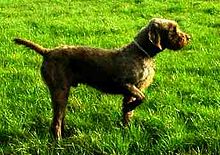Pointing dog

As Pointing all dogs or all breeds referred to as hunting dogs the behavior of the protrusion show pronounced. The hunter recognizes that the dog has found game by the protrusion of the dog . The ability to point is an innate behavior that has been reinforced by selection and which can be furthered in the training of the pointing dog. The FCI leads these dogs in group 7 .
properties
It is characteristic of all these dogs that they use their sense of smell to indicate game to the hunter by pointing. In doing so, they persist in their movement without making a sound and usually lift a foreleg at the same time, and more rarely a hindquarters, and bend it. The hunter can prepare for firing, then, but has found the dog from wild even startle ( make up ). Pointing dogs are trained for this special ability and are not intended to scare away or even chase the prey themselves. If the dog protruding first time ever farther away from the game, it shows then ideally the behavior of redrawing . In doing so, he approaches the game with slow movements and then stands in front again. Wild game that has been raised must never be pursued by the dog, which can be prevented by preventive training.
history
Pointing dogs were also used in tirassing , and the dogs that were used to hunt poultry were also known as chicken dogs. In England, the sport of bird hunting for poultry began to develop with setters n (English setting dogs for sitting dogs ), who lie down while showing the game. Pointer contrast, have ideally like an arrow (English -to-point of show ) toward the tracked wild. With the tip of their nose they point exactly in the direction of the source of the odor, especially when there is no visual contact.
Races
Pointing dogs are hunting dogs and are divided into two sections in the FCI system , Continental Pointing Dogs and English and Irish Pointing Dogs .
Type "Braque" means short-haired pointing dog, not bracke .Likewise, the "Spaniel" type is a long-haired pointing dog, not a poking dog (spaniel) andthe type "Griffon" describes the rough-haired pointing dog.
The following breeds belong to the pointing dogs:
Continental pointing dogs

- Type "Braque" (short-haired, section 1.1)
- Old Danish pointing dog
- Bracco Italiano
- Braque de l'Ariège
- Braque du Bourbonnais
- Braque d'Auvergne
- Braque français (Gascogne type, Pyrénées type)
- Braque Saint-Germain
- German Wirehaired Pointer
- German Shorthaired Pointer
- German Stichelhaar
- Magyar Vizsla (Wirehaired Pointer)
- Magyar Vizsla (Shorthair)
- Perdigueiro Português
- Perdiguero de Burgos
- Poodle pointer
- Weimaraner (long-haired, short-haired)
- Type "Spaniel" (long-haired, section 1.2)
- Type "Griffon" (wire-haired, Section 1.3)
English and Irish Pointers
Section 2
Section 2.1
Section 2.2
See also: List of FCI dog breeds
literature
- Carl Schneider: Instructions, thorough = appropriate to train a young chicken dog parforces to train. School bookshop, Braunschweig 1791.
- Instructions, thorough = appropriate training for the training of a young chicken dog parforces: In addition to an appendix on catching larks and becassins, a brief description of the associated nets and their knitting. School bookshop, Braunschweig 1795.
- Friedrich Oswald : The pointing dog in its full value. Leipzig 1855.
Web links
- Video: Pointing out with dragging: https://www.youtube.com/watch?v=bQv-pxwNB38
Individual evidence
- ↑ Hunting dog training - whistle as an interruption signal on wildundhund.de (article from 2013)
- ↑ After Meyers Encyclopedia , Volume 9, 5th ed. (1896), Ed. Bibliographer. Inst., Leipzig a. Vienna, pp. 61–62, the terms pointing dog and chicken dog used to be equated.
- ^ Gabriele Lehari: The other breed portrait: Braque d'Auvergne. In: The dog. 5/2013 p. 32. ISSN 0323-4924
- ^ Bavarian State Library digital
